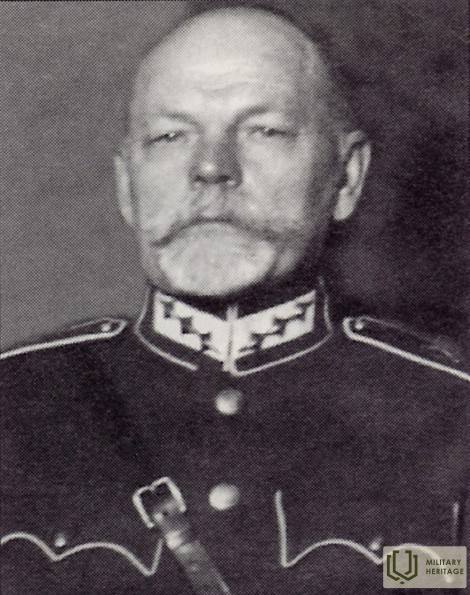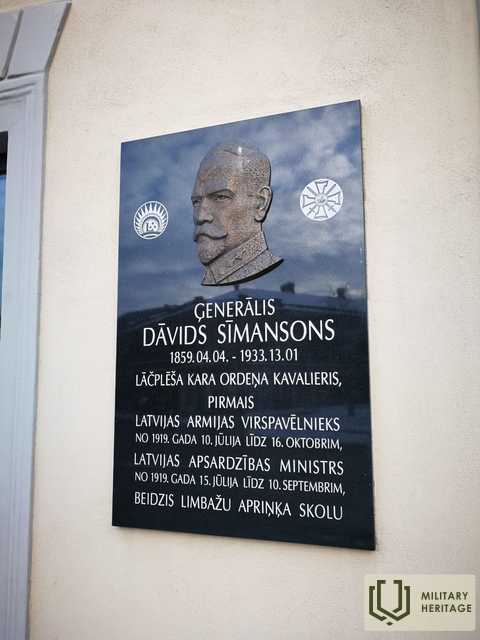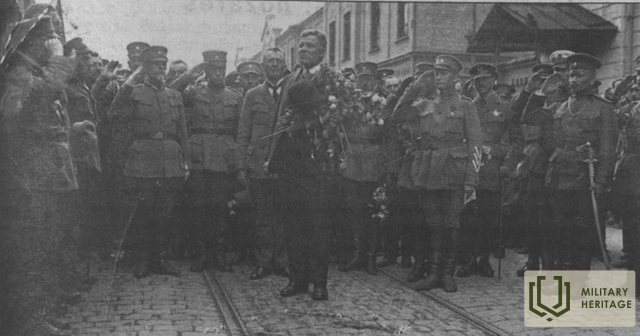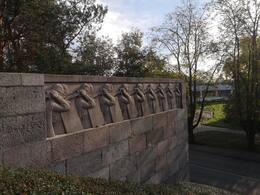About the first Commander-in-Chief of the Latvian Army, Dāvids Sīmansons
The essays in the book "Commanders of the Latvian Army" convince us that history is significantly influenced by specific individuals. Although they were at the epicenter of the most important historical events for a short time, true Latvian patriots, with their rich military experience, managed to do a lot in the formation and strengthening of the Latvian army and in the turning points of historical events.
This story is about the first Commander-in-Chief of the Latvian Army, Dāvids Sīmansons (1859-1933).
Dāvids Sīmansons was born on April 4, 1859 in Pilāti, Valmiera parish. He graduated from the Limbaži district school. In 1880, he voluntarily joined the army, in the 115th Infantry Regiment. In 1881, D. Sīmansons entered the Riga Junkers School, which he graduated in 1883 as an ensign. In 1888, he received the rank of second lieutenant. In 1891, he entered the General Staff Academy. In 1892, D. Sīmansons received the rank of lieutenant, which was followed by the ranks of staff captain (1899), captain (1901) and lieutenant colonel (March 1904).
From 1904 to 1905, D. Sīmansons participated in the Russo-Japanese War; from 1910 to 1912, he was a senior officer in the staff. In 1910, he received the rank of colonel, and in May 1915, he received the rank of major general. Until the end of 1917, D. Sīmansons commanded various army units - the battalion of the 116th Infantry Regiment, the 66th Infantry Regiment, the 17th Division Brigade, the Kaluga Separate Brigade, the 135th Division and the 4th Separate Division. He was also wounded several times in battles. In October 1917, D. Sīmansons left the service and returned to Riga in January 1919. On June 6, 1919, D. Sīmansons, already as a general, joined the armed forces of the Latvian Provisional Government, the 1st Latvian Separate Brigade.
The work of Oskars Kalpas (1882-1919) was directly continued by Lieutenant Colonel Jānis Balodis (1881-1965), who in April 1919 established the 1st Latvian Separate Brigade on the basis of the Kalpaks Battalion, which, like the O. Kalpaks Battalion, was subordinated to the German Landeswehr High Command. Therefore, the formation of the Latvian Army began only on July 10, 1919, after the unification of the 1st Latvian Separate Brigade and the North Latvian Brigade commanded by Jorģis Zemitāns (1873-1928). General Dāvids Sīmansons, who had come from Russia, was appointed its first commander-in-chief, who had not served in Latvian regiments and whose activities were less well known to the Latvian public.
At the same time, from July 15 to September 5, he was also the Minister of Security of the Provisional Government, which was approved by the People's Council, transformed and supplemented by some representatives of minorities.
The then Chief of the Press Department of the Supreme Commander's Staff of the Army - Captain Aleksandrs Plensners - wrote that he was largely chosen for the position of Supreme Commander as a compromise figure, so that he would not have to choose between J. Zemitāns and J. Baložs, amid the contradictions between the so-called "northerners" and "southerners" after the Battle of Cēsis, in which the brigade commanded by J. Baložs did not participate or maintained neutrality.
Plesner wrote about his impressions: “[...] He was already 60 years old, a great age in my perception at the time, but I couldn’t feel it much. It seems to me that he represented the type of Russian regular general well. With a sword belt over a noticeable belly. However, attentive and kind to people, no matter who they were. I was left with a good impression of him. Of course, he had entered a completely different atmosphere and a completely different army than he had served in before. From his previous point of view, he had now become a rebel commander. It seemed that he did not dislike this task. It was just that it was still new and unusual for him. He had to get used to it. And he tried to do this with a noticeable will to understand. It seems that the Latvian blood had not yet dried up in him.”
During this difficult time, the commander-in-chief had to deal with a variety of issues related to the existence of the new army – fuel, medical, and political issues.
The peculiarities of the Commander-in-Chief's work are also characterized by the fact that at the beginning there were some ambiguities with the numbering of the regiments. They reflected the competition between the officer groups of the Latvian Army, the already mentioned so-called "northerners" and "southerners".
At the end of August, Commander-in-Chief David Simonsons participated in a meeting of representatives of the anti-terrorist forces in Riga, where the Polish military representative Aleksander Miskowski pointed out Bermont's true intentions. Immediately afterwards, on August 30, Simonsons submitted his resignation from the post of Minister of War, "because he only wants to be the Commander-in-Chief of the Army, since he has only assumed the duties of Minister of War for the time being."
Apparently, the crisis of the Bermont troops was brewing; by early October, it was already clear to the government and the army high command that there would be a conflict.
On October 6, the commander-in-chief of the army, D. Sīmansons, in an encrypted telegram, authorized the military representative Mārtiņš Hartmanis to ask the leadership of the Polish army to open hostilities against Bermont's units, which were "advancing from Courland and Lithuania" in a northeasterly direction. On October 8, Bermont's forces began their attack on Riga.
Already on October 11, the Ministry of Defense held a meeting between Commander-in-Chief D. Sīmansons and the heads of the French and British missions regarding Bermont's call to conclude an armistice and agree on joint action against the Red Army. Opinions were divided and the answer was not sent immediately. D. Sīmansons refused only a few days later. On October 14-15, parts of the Latgale Division launched an attack across the Daugava bridges, suffering heavy losses, and at the same time, with the support of the Allied flotilla artillery, Daugavgrīva and Bolderāja were captured.
In 1926, D. Sīmansons was awarded the Lāčplēsis War Order, 3rd Class, for the fact that on October 9-10, "with his reasonable and energetic actions, he saved the soldiers from danger, moved all our units to the right bank of the Daugava, leaving no trophies for the enemy. With selfless actions, he held out against all the enemy's superior blows and very soon began an attack, as a result of which Daugavgrīva and Bolderaja were liberated, which to a large extent contributed to the liberation of all of Riga."
On October 15, D.Sīmansons submitted a request to the government to release himself. The failures at the beginning of the Bermont attack proved too serious for his health.
The next day he was put in reserve. Plensner admitted that Simansons had been called to retreat. By deciding to resist and punish Zemitāns for ordering him to retreat from Riga, he had acted contrary to the intentions of the government, which wanted to protect the city.
Zemitāns had issued the order to resign on Ulmanis's orders. This is indirectly confirmed by the fact that Foreign Minister Zigfrīds Anna Meierovics, while leaving for Poland, offered the position of commander-in-chief to Balodis already on October 14, and also by the fact that on October 17, when Balodis arrived in Riga, Sīmansons, apparently offended and, citing illness, did not appear at headquarters to hand over the position.
Historian Edgars Andersons believes that Sīmansons was replaced by Balodis at Ulmanis's initiative. It is noteworthy that after Bermont was expelled from Latvia, Ulmanis once again thanked Sīmansons "for the work of organizing the army, which the general had begun and which is now being completed."
From December 1920, Sīmansons was a member of the Council of the Ministry of Defense (War), and since 1924, acting chairman of the Council.
At the end of 1921, the then Chairman of the War Council, Kārlis Goppers, wrote in his attestation: “A clear conscience and clarity of principles do not allow him to dwell on the current unresolved circumstances, which often upset and worry him. Strong self-sacrifice in the war has taken its toll on his health, which no longer allows him to develop the energy and endurance in work to which he is accustomed.”
In February 1925, Sīmansons was put on leave. In the summer of 1930, the press noted: “On sunny days, in the alleys of the Esplanade or in the greenery of Vērmaņa Garden, one can meet an old soldier in a general’s uniform. Leaning on a cane, he takes each step, as if carrying the burden of his long life and years as a soldier. Many have no idea that this old man is the oldest Latvian soldier and also our oldest general.”
David Simonsons died on January 13, 1933, in the Riga Military Hospital, where he had been admitted as early as the end of 1932. The general was taken out of the Riga Cathedral and buried with military honors in the Brothers' Cemetery next to the statue of "Mother Latvia."
In 2013, a memorial plaque to D. Sīmansons was installed in Limbaži, near the facade of the former city council building (Baumaņa Kārļa laukums 1).
During his military career, D. Sīmansons received awards - the Latvian 3rd class Lāčplēsis War Order, the Defenders' Cross of Merit; the Russian St. George's Sword, the 3rd and 4th class Order of St. Vladimir, the 2nd and 3rd class Order of St. Stanislav, the 3rd class Order of St. Anna.
"Commanders of the Latvian Army", publishing house "Jumava", 2018.
Related timeline
Related topics
Related objects
Sudrabkalniņš hill - memorial for fight against Bermondt army
Located in Riga, Pārdaugava, at the intersection of Slokas and Kurzemes avenues.
In early November 1919, during the Latvian War of Independence, street battles between the Latvian Army and Bermont's troops took place in Pārdaugava. The decisive attack on Bermont's army took place in this area. In 1937, a monument was unveiled in Sudrabkalniņš, according to the project of Kārlis Zāle, honoring the fallen soldiers of the 6th Riga Infantry Regiment and highlighting their military qualities.
Designed as a memorial wall – a symbolic fortification, the gate of which depicts a lion blocking the way to the enemy’s attack. Built from stone blocks of the Daugavgrīva Fortress defensive rampart and hewn from the granite left over from the Freedom Monument. The cost of the memorial site amounted to almost 35,000 lats. For comparison, 4 “Ford - Shield V8 De Luxe” cars made in Latvia could be purchased for this amount.
Today, you can visit one of the most impressive memorials of the War of Independence.
Brothers' Cemetery in Riga
Riga Brothers’ Cemetery is located in the northern district of Riga. The cemetery extends over an area of 9 ha and is the most outstanding and significant memorial ensemble in Latvia dedicated to the fallen Latvian soldiers. About 3,000 soldiers are buried here. The Brothers’ Cemetery was created during World War I after the first three Latvian Riflemen, who fell in Tīreļpurvs in the battle against the German Army, were buried here. Later Latvian soldiers who had died in other battles and wars would also be buried in the Brothers’ Cemetery. The memorial is based on the design of the sculptor Kārlis Zāle, and is the first memorial ensemble in Europe with such landscape, architecture and sculptural value. It uses elements typical to the Latvian landscape, traditional farmsteads, Latvian folklore and history that praise the characteristics of soldiers and tell the story of the way of the soldier. The memorial was unveiled in 1936 and it has three parts: ‘The Road of Though’ which is a 250 m long alley, ‘Terrace of Heroes’ with the Altar of the Sacred Flame and ensemble the Sacred Oak Grove, and the burial ground with the Latvian wall and a memorial of a mother with her fallen sons.










